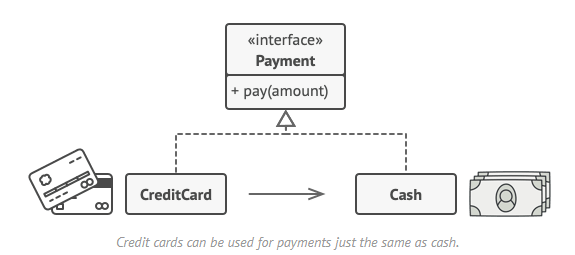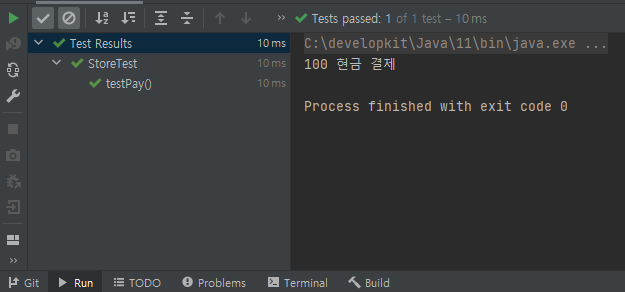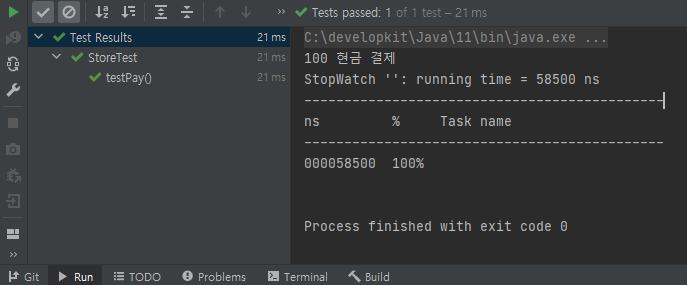스프링 AOP
Aspect Oriented Programming
다양한 AOP
- 구현 방법 3가지
- 컴파일
- A.java —-AOP—-> A.class (제공 : AspectJ)
- : 자바코드에는 없지만 컴파일을 한 코드에는 있는 것처럼 컴파일 해주는!
- 바이트코드 조작
- A.java → A.class ——AOP(위치 : 클래스 로더)——> 메모리 (제공 : AspectJ)
- 프록시 패턴
- 스프링 AOP, 디자인 패턴을 사용해서 AOP와 같은 효과를 내는 방법. (참고 : https://refactoring.guru/design-patterns/proxy)
- 컴파일
프록시 패턴
-
기존 코드 건드리지 않고 새 기능 추가하기
-
프록시 패턴

-
Main에서의 클래스
-
main\java\org...\proxy\Storepackage org.springframework.samples.petclinic.proxy; public class Store { Payment payment; public Store(Payment payment) { this.payment = payment; } public void buySomething(){ payment.pay(100); } } -
main\java\org...\proxy\Cashpackage org.springframework.samples.petclinic.proxy; public class Cash implements Payment{ @Override public void pay(int amount) { System.out.println(amount + " 현금 결제"); } } -
main\java\org...\proxy\Paymentpackage org.springframework.samples.petclinic.proxy; public interface Payment { void pay(int amount); } -
main\java\org...\proxy\CashPerfpackage org.springframework.samples.petclinic.proxy; import org.springframework.util.StopWatch; public class CashPerf implements Payment { Payment cash = new Cash(); @Override public void pay(int amount) { StopWatch stopWatch = new StopWatch(); stopWatch.start(); cash.pay(amount); stopWatch.stop(); System.out.println(stopWatch.prettyPrint()); } } //일종의 프록시
-
-
Test 확인
-
test\java\org...\proxy\StoreTestpackage org.springframework.samples.petclinic.proxy; import org.junit.jupiter.api.Test; import static org.junit.jupiter.api.Assertions.*; class StoreTest { @Test public void testPay(){ //Payment cashPerf = new Cash(); //(1) Payment cashPerf = new CashPerf(); **//(2)** Store store = new Store(cashPerf); store.buySomething(100); } } -
(1)

-
(2) - 프록시 클래스를 사용하도록 함.

-
-
원래는 Cash가 Bean으로 등록이 되어야 하는데 내가 만들고 싶은 CashPerf(proxy)가 자동으로 생겨서 Cash 대신에 등록이 되고 Client가 CashPerf를 대신 쓰게 되는 일이 Spring 내부에서 발생한다.
-
스프링 AOP 기반의
@Transactional이 위와 같은 일을 한다.
스프링 @AOP 실습
-
@LogExecutionTime설정(어디에 적용할지)@Target(ElementType.METHOD) @Retention(RetentionPolicy.RUNTIME) public @interface LogExecutionTime { } //위치 : java\org..\owner\LogExecutionTime@Target: 어디에 쓸 수 있는지.@Retension:@정보를 언제까지 유지할 것인가.
-
java\org..\owner\LogAspect: 스프링 AOP(프록시 패턴 기반)Proxy 패턴(스프링 AOP)
@Component @Aspect public class LogAspect { Logger logger = LoggerFactory.getLogger(LogAspect.class); **@Around("@annotation(LogExecutionTime)")** public Object logExecutionTime(ProceedingJoinPoint joinPoint) throws Throwable { StopWatch stopWatch = new StopWatch(); stopWatch.start(); Object proceed = joinPoint.proceed(); stopWatch.stop(); logger.info(stopWatch.prettyPrint()); return proceed; } }- joinPoint 파라미터 =
@LogExecutionTime이 붙은 메소드(타겟) @Around("@annotaion(LogExecutionTime)"): LogExecutionTime이라는@주변에 적용하겠다.@Around외에도@After,@Before등.@annotation외에도@Bean, Method들이 진행되는 시점 등.
- joinPoint 파라미터 =
-
java\org..\owner\OwnerController에서 성능(시간)을 측정할 메소드 위에@LogExecutionTime을 추가하자.Target(타겟)
@GetMapping("/owners/new") @LogExecutionTime public String initCreationForm(Map<String, Object> model) { Owner owner = new Owner(); model.put("owner", owner); return VIEWS_OWNER_CREATE_OR_UPDATE_FORM; } @PostMapping("/owners/new") @LogExecutionTime public String processCreationForm(@Valid Owner owner, BindingResult result) { if (result.hasErrors()) { return VIEWS_OWNER_CREATE_OR_UPDATE_FORM; } else { this.owners.save(owner); return "redirect:/owners/" + owner.getId(); } } @GetMapping("/owners/find") @LogExecutionTime public String initFindForm(Map<String, Object> model) { model.put("owner", new Owner()); return "owners/findOwners"; }- 앱을 실행하고
@LogExecutionTime이 명시된 메소드들이 실행될 때 각 메소드들이 실행되는 시간, 즉 성능을 Runtime으로 표시한다.
- 앱을 실행하고
